
IntraCoastal Waterway
American Sabbatical 70: 3/13/97
Somerset Place
3/13.. In my mind I’m gone
I stood bolt upright at 6AM, had my uniform on and was out the door in two minutes, waved
my ID at the gate of NAVSTA NORVA and woke up at my desk at CINCLANTFLT
wondering what was going on... oop.. wrong decade.
Peggy says we survived all that by always laughing at our absurdity.
Like the night she painted the bottom of my navy dogs dayglo orange,
so I’d flicker when I ran, and I scuffed my feet for a month.
Or the night she wrote “Fuck you, sir” on the edge of my saluting
hand, and next morning at inspection I had a moment of horror
as I sleepily came to attention. Or the times my CO called Peggy
in to criticize the way she was cutting my hair.. or to gawk at
those gorgeous legs (as I suspected). It was so much fun, maybe
I should have been a lifer. Not on your life, sez Peggy.

IntraCoastal Waterway
We escaped Navyburg one last time, arched over the Chesapeake
and Albermarle Canal of the IntraCoastal Waterway, and made tracks
for the outer banks. We were finally veering away from the Eastern
Megalopolis and its persistent exurbia, and signs of rural poverty
began to outnumber the housing starts. The older buildings had
a uniquely Southern character: low narrow tin-roofed houses crowded
together, their pillared porches across the gable-ends all close
to the road, and tall narrow two and a half story brick halls
with tin mansard roofs and tiny dormers standing solitary in the
flat agrarian expanses. First crops coming up, and tractors making
dust plumes in the fields.
Nags Head on the far side of Currituck Sound is another kettle
of fish. Clusters of elaborately architected condos on stilts
or false first stories, sanitized minimalls, and lots of geriatric
services. We hauled into a food mart for bread and cheese and
juice, and felt like infants among our elders. Back in Columbia
Maryland, Roni had pointed out that the planned communities of
the 60’s hadn’t considered aging as a possibility, and were suffering
the wages of age segregation. Suburbs are about strollers not
walkers. Now Columbia is trying to insert infrastructure so those
who invested in those community dreams have places to grow old
in, and battles over tax allocations are getting polarized. Out
here on the condo banks you don’t have to worry about school appropriations,
to judge by the mall lots. Chiropractors next to recycled books,
wheelchairs in the windows next to the beauty parlor. The elders
have made a beach-head.
We were looking for what was billed as a remnant hardwood forest
at the ocean’s edge, and saluted Orvil and Wilbur as we skirted
the Kitty Hawk Monument. Ain’t history grand? We can make an historic
site out of a sand dune because a couple of dreamers from Dayton
kept hurling themselves into the wind there. At least there’s
still a there there. The forest was gone. Or at least we couldn’t
find signs, or see any groves along the shore. We did find the
ark, though. Built to Noah’s dimensions, and pointed seaward on
the Kill Devil Hills / Nag’s Head line. Hallelujah... this is
the Carolines, and every third building offers redemption. Converted
gas stations (what a concept), tumbling shanties with tilting
spires, foursquare brick churches, and roadside shrines. We pulled
into a state parking lot overlooking a marsh and said our blessings
over mozzarella strings and oranges.
The pilot was getting cranky and the navigator suggested he go
for a long walk... so we scuttled across Roanoke Island (where
they celebrate The Lost Colony which they think was maybe there
they guess), crossed Coatan Sound, and took a back road, down
a side road, off a byroad, and came bumper to reedbank with a
blackwater guzzle off the Alligator River. Easterly breeze picking
up and pushing on the feathery swamp grasses. No beach, no banks,
just ooze and reeds. Foiled again.
Back on highwaya firma we hotfooted along the south shore of Pamlico
Sound, following die-straight two-lanes paralleling blackwater
ditches 20 feet across. Big pines and luxuriant hardwoods lined
these canals, the latter all red and orange with bursting buds.
The oaks (if that’s what they are) have dark green balls of mistletoe
floating in their branches like contrasting clouds against the
spring reds. The signs warned of red wolf crossings, but all we
saw was a painted turtle in a drainage ditch. Off to one side
was acre after acre of pine plantation, on the other lowland jungle,
strangled in vines and choked with extravagant thickets.
Ms. Navigator had us lined up on Somerset Place, six miles south
of Creswell, a plantation on Phelps Lake, in the middle of all
this lowlying muck. And Creswell itself was the first real Southern
town we’ve driven through, or it felt that way. Tin-roofed and
sided stores lining a wide dusty street, and an air of somnolence
in the mid-day sun. Old men chatting in the porch shade. Scuse
me if I wax stereotypical. An elderly black man was filling a
milkjug with water at a hand pump in front of one store... and
our pony whinneyed as we trotted past.
Somerset Place was out of time, too, and I drifted off down a
track through the cypress woods while Peggy did the teacher-tour
thing. Cypress: my first encounter with these wetfooted giants,
and I felt honored. Green briars wove fences between the bolls,
and the leaf-littered surface was a stageset for erupting cypress
knees, each one a convivial personality.. or a carving to be.
I could go wild in a place like this. And purple-blue trumpet-shaped
flowers scattered here and there. Temperature in the 70’s in the
woods, but a storm wind starting to keen in the tops.
I went back to the mansion house to draw a cluster of yellow outbuildings among the big old cypress and sycamores, and a student volunteer who was painting the white picket fences came over to kibbitz. We agreed that drawings could put you right back in a place because you looked so intently in the drawing of them. And I’ll see her earnest face with white smudges across it the next time I look at this one.
(Memo #60)
March 13 superb SOMERSET PLACE PLANTATION, Creswell, N.C. FOUR STARS ! A “10”! THE HIGH POINT OF THE TRIP SO FAR!
Who? 3 partners, Josiah Collins bought out two.
What? RICE plantation, one of the four largest plantations in
N.C
Where? marshy area of northeastern N.C. on Lake Phelps
When? land bought 1784, worked until Civil War
How? marsh land drained
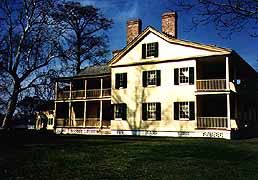
Main House
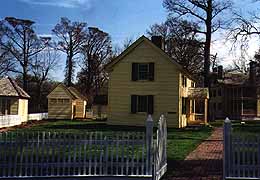
Out Buildings
Topics: rice plantations, representing enslaved people, plantation
reconstruction
Questions: How distinctive was rice agriculture? What was a rice
plantation like?
It’s hard to stay calm writing about this phenomenal site. It
is SO much better than any plantation (almost any historical site)
I’ve seen. It tells the plantation story more fully and sensitively
than anywhere else! Many plantation tours show you the big house
with damask and antiques and fine china and the guide casually
refers to the 150 slaves who were there. Somerset Place gives
faces and personalities to the white AND blacks who are part of
the story. The view presented owes a lot to Dorothy Redford, the
Director, who is a descendant of a Somerset Place slave. She and
the staff use the phrase “enslaved people” to emphasize the common
humanity of white and black. The details given throughout the
tour are stunning (for example, Ms. Radford’s ancestor was sold
after joining an unsuccessful plot to poison the overseer).
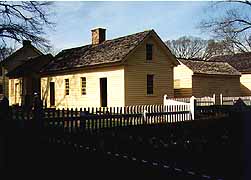
Another view
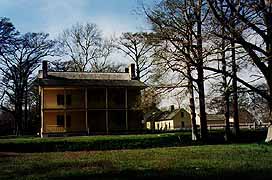
Across the canal
Statistics. The successful white planter (Josiah Collins) and
his plantation Somerset Place represented here was only a small
percent of the population of the pre Civil War South. Somerset
Place was one of the four plantations in North Carolina with over
300 slaves. There were perhaps 150 North Carolina planters with
100-300 slaves, 4000 small planters with 20-100 slaves, 30,600
slave holding farmers with 1-18 slaves, and over 87,000 yeoman
farmers with no slaves, plus an unknown number of laborers-tenant
farmers, 30,500 free blacks, and 331,000 slaves/enslaved people.
There are many unusual aspects to Somerset Place. It was created
in 1784 when three rich men from the town of Edenton formed a
company and bought 100,000 acres around Lake Phelps in northeast
North Carolina to start a rice plantation. Josiah Collins eventually
bought out his two partners and his family ran the plantation
until the Civil War. The company’s original goal was a profit
in five years; it was successful. The land was too marshy to cultivate.
The partners hired whites and blacks to make a start on drainage,
then sent their own ship (the Camden) to get 80 slaves directly
from a rice-growing area of West Africa (most Americans got “seasoned”
slaves from the Caribbean, or from slave markets here). They did
buy 49 more slaves here in the States.The enslaved people worked
for two years to dig a six mile long canal to drain the swamp.
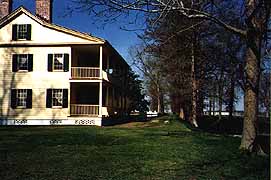
Up canal
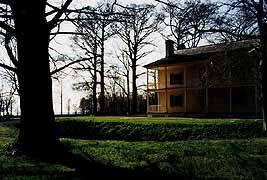
Down canal
You follow this twenty foot wide canal as you approach up a long
avenue of cypress trees. The lake and house are at a slightly
higher elevation than the surrounding land, so the lakeflow into
the canal powered a grist mill and two saw mills not far from
the main house. The canal carried supplies and boaters - two of
the planter’s sons and two enslaved boys died together in this
canal when a boat overturned.
The marshy site meant that malaria was endemic. The first two
Josiah Collins lived in Edenton. The planter families of the lowlands
went away in the summer, north to places like Saratoga Springs,
or to summer houses on the beach or upland.
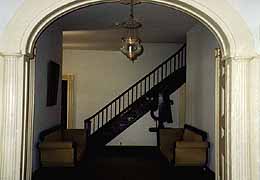
Stairwell
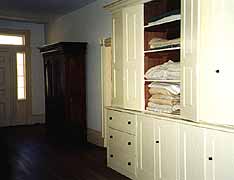
Linens
At its height the plantation had 4000 acres under cultivation
and over fifty buildings. The mansion house has 14 rooms with
7000 square feet (the guide tells you this was the equivalent
of 188 slave quarters!). Near the main house we toured the smaller
original house (exhibit space and store now, when the main house
was built it became a schoolhouse-dormitory for the planter’s
sons), the cookhouse and laundry, smokehouse, storehouse, salthouse
(they processed 200 pigs a year), ice house, dairy, flower garden.
The kitchen is the oldest of the original outbuildings and dates
from 1821. Grace Spinnet, an enslaved woman, presided there for
years directing the three person staff that served three meals
a day to perhaps 20 people in the main house. There was a three
acre herb and vegetable garden. Again unlike many plantations
we’ve seen, the outbuildings are original.
Archaeology and plantation records have determined the site and
size of the 26 slave cabins (quarters) on “the Street” , a half-mile
long lane that faced the lake. At right angles is the second plantation
lane where the enslaved people had their field kitchen, craft
cabin, hospital (they were tended by the same doctor as the planter
family) and the Episcopal chapel. The chapel and hospital were
the only ones with glass windows. Many of the foundations can
be seen. At the corner of the two lanes was the two-story cabin
of Old Suckey an enslaved woman who was leader of the black community
in the mid 1800’s and the matriarch of a huge family.
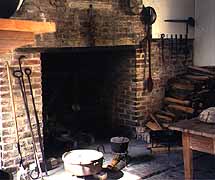
Kitchen Hearth

Window
The mansion is gorgeous, a huge yellow house with columns and
verandas off both stories. It’s set at right angles to the nearby
lake facing a 12 acre front lawn across the canal. Huge cypress
trees shade the site. The original house has a large hall with
two rooms off either side. A later extension off the back houses
the large formal dining room downstairs and the master bedroom
up. The period furniture with a few exceptions is not original.
There are paintings of the Simmons family throughout. Xeroxes
of the extensive records are on the study table. Upstairs the
hall has a huge built-in linen closet and four bedrooms. Period
furniture (including “close” stools, the interior toilets) is
found throughout. The third floor had the children’s dormitory
room, a playroom and a room for a free blackwoman named Charlotte
who came as nursemaid and stayed her entire life as household
aide. Her story is fascinating (her father was white and lived
openly with a black woman, Charlotte had some education).
Plantation houses were constructed by a combination of craftsmen
(free, indentured, enslaved). Some are known (like the French
Stucco Man at Mt. Vernon). At Somerset Place they know about the
free Blackman who did the painting of the marbleized baseboards.
A beautiful many-paned window made by an enslaved man is thought
to replicate an African design.
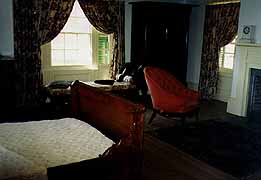
Bedroom
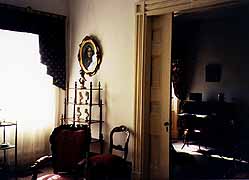
Parlor
Dorothy Redford has extended the research and narration to include
all the members of the past and present community. Somerset Place
Plantation was a community of blacks and whites. It still is.
Extensive education programs with many hands-on activities are
run by researchers, volunteers, and guides. An upbeat group of
Youth Conservation Corps teenagers and college volunteers was
painting and joking as we toured. In 1986 a reunion of descendants
of Somerset Place (black and white) drew hundreds of people to
the site.
Somerset Place is superb !
3/13.. cont.
Then Peggy came out with her face all radiant, raving about the exhibitions, and
her enthusiasm lifted us along the long miles to Topsail Beach.
We were homing in on my Brother Lyle’s rented house on hurricane
alley, and it was still a long slog across the state. Through
mile after mile of pine plantation, past the big Weyerhauser mill
on the banks of the Pamlico River, making that sulfurous money-stink
that we know and love in Maine. Down your paper trees, up your
dioxins. And bumper to bumper at 65 with Garth and Co. booming
on the CW station, past New Bern and into Jacksonville, home of
Camp LeJeune. You can tell this is a military town by all the
amenities along the strip.. and I do mean strip. Tattoo parlors
and jiffy lubes, adult entertainments and Macburgers, fast this
and quickie that. Hang onto me honey.
Lyle is a lieutenant in the Corps, and shares a house on the beach
with two other looies, so we expect the place to shine and salute
us. But when we go over the bridge to Topsail Island the devastation
from last year’s hurricanes puts a different spin on this bivouac.
The rows of condos and cottages are full of great gaps where all
the rubble has been carted off, but there are still collapsed
structures everywhere, and contractors’ vehicles in every other
drive. What trees there are all lean inland at rakish angles as
if the wind were still raging.
Actually it’s getting up pretty good when we disembark at Lyle’s.
He’s not back from maneuvers, or whatever, yet, so we go for a
hike on the beach, which looks scoured down to a hardpan of broken
shells embedded in compacted sand. The steps which once descended
from the houses to the beach have been ripped away from the remaining
buildings, and the stump ends hang in mid-air, or have been replaced
by shining new constructions, but the dunes which once fronted
these getaways gotaway completely, and only a single steep bank
up against the first row of houses remains.
Lyle’s house only suffered passing damage. Ground floor walls
blown out (as they were designed to do). Four feet of sand in
the garages, and a collapsed ceiling under the upstairs decks,
from water damage. The combination of 3 marines and a hurricane
gives this house a camped-in ambiance, and we’ll be happy to do
just that for the next couple of days.. and let this storm rage
outside. The booming surf and lashing rain sure soothes a vagabond
spirit.